Light Railway Network Design: Phases, Testing, and Human Factors
VerifiedAdded on 2020/04/01
|15
|3858
|51
Report
AI Summary
This report provides a comprehensive analysis of the design and implementation of light railway networks, a vital component of modern urban transportation systems. It begins by examining the preliminary design phase, which is crucial for establishing the foundational elements of the network, including the specifications for various components such as power systems, signaling, and rolling stock. The report then moves on to the detailed design phase, where the fabrication of the network takes place, with an emphasis on iterative processes and the application of various engineering tools and methodologies. The system test, evaluation, and validation phase is discussed, highlighting the importance of ensuring compliance with industry standards and client requirements, along with optimization strategies. The report concludes by addressing critical human factors, such as safety and comfort, which are essential for the successful operation and user acceptance of the light railway network. The report emphasizes the importance of considering all these phases and human factors to ensure the development of a functional, sustainable, and user-friendly light railway system.

Designing of Light Railway Network 1
DESIGNING OF LIGHT RAILWAY NETWORK
Name
Course
Professor
University
City/state
Date
DESIGNING OF LIGHT RAILWAY NETWORK
Name
Course
Professor
University
City/state
Date
Paraphrase This Document
Need a fresh take? Get an instant paraphrase of this document with our AI Paraphraser

Designing of Light Railway Network 2
Executive Summary
Urban demographics are always changing and putting a lot of stress on available transportation
systems. Light railway network is one of the public transportation systems that many cities
across the world are using to reduce traffic congestion and carbon emission, and provide reliable,
safe and affordable transport for city dwellers. This report analyzes various phases that follows
conceptual design phase when implementing a light railway network project. The phases
analyzed are: preliminary design phase, detailed design phase, and testing, evaluation and
validation phase. These phases are very crucial as they ensure that the system developed meets
the specified technical and functional requirements. The report also discussed human factors that
are critical when developing a light railway network. When all the phases and human factors are
considered appropriately, it becomes easy to ensure that the light railway network developed
meets its requirements, including functionality, usability, constructability, interoperability,
sustainability, maintainability, reliability, serviceability and affordability.
Executive Summary
Urban demographics are always changing and putting a lot of stress on available transportation
systems. Light railway network is one of the public transportation systems that many cities
across the world are using to reduce traffic congestion and carbon emission, and provide reliable,
safe and affordable transport for city dwellers. This report analyzes various phases that follows
conceptual design phase when implementing a light railway network project. The phases
analyzed are: preliminary design phase, detailed design phase, and testing, evaluation and
validation phase. These phases are very crucial as they ensure that the system developed meets
the specified technical and functional requirements. The report also discussed human factors that
are critical when developing a light railway network. When all the phases and human factors are
considered appropriately, it becomes easy to ensure that the light railway network developed
meets its requirements, including functionality, usability, constructability, interoperability,
sustainability, maintainability, reliability, serviceability and affordability.
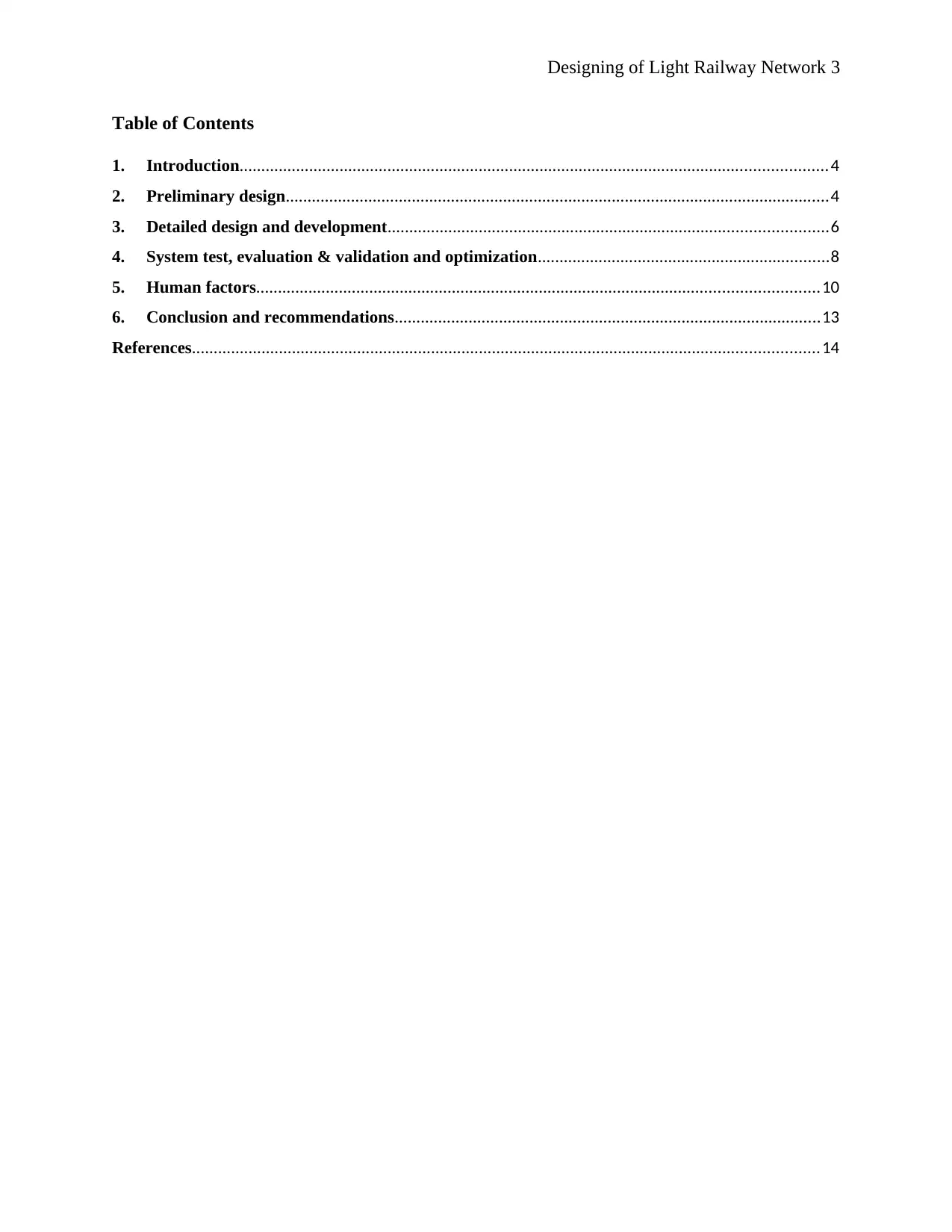
Designing of Light Railway Network 3
Table of Contents
1. Introduction.......................................................................................................................................4
2. Preliminary design.............................................................................................................................4
3. Detailed design and development.....................................................................................................6
4. System test, evaluation & validation and optimization...................................................................8
5. Human factors.................................................................................................................................10
6. Conclusion and recommendations..................................................................................................13
References................................................................................................................................................14
Table of Contents
1. Introduction.......................................................................................................................................4
2. Preliminary design.............................................................................................................................4
3. Detailed design and development.....................................................................................................6
4. System test, evaluation & validation and optimization...................................................................8
5. Human factors.................................................................................................................................10
6. Conclusion and recommendations..................................................................................................13
References................................................................................................................................................14
⊘ This is a preview!⊘
Do you want full access?
Subscribe today to unlock all pages.

Trusted by 1+ million students worldwide
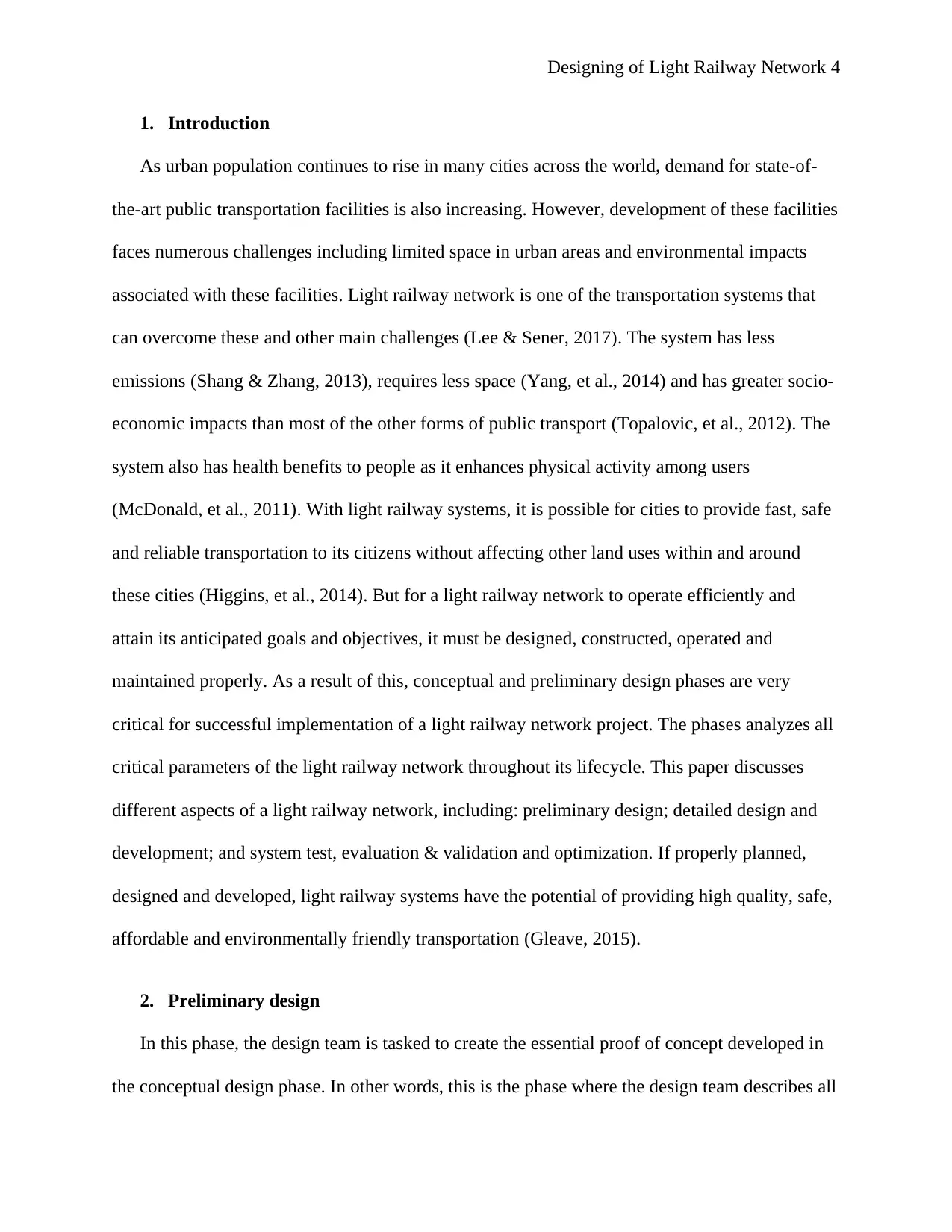
Designing of Light Railway Network 4
1. Introduction
As urban population continues to rise in many cities across the world, demand for state-of-
the-art public transportation facilities is also increasing. However, development of these facilities
faces numerous challenges including limited space in urban areas and environmental impacts
associated with these facilities. Light railway network is one of the transportation systems that
can overcome these and other main challenges (Lee & Sener, 2017). The system has less
emissions (Shang & Zhang, 2013), requires less space (Yang, et al., 2014) and has greater socio-
economic impacts than most of the other forms of public transport (Topalovic, et al., 2012). The
system also has health benefits to people as it enhances physical activity among users
(McDonald, et al., 2011). With light railway systems, it is possible for cities to provide fast, safe
and reliable transportation to its citizens without affecting other land uses within and around
these cities (Higgins, et al., 2014). But for a light railway network to operate efficiently and
attain its anticipated goals and objectives, it must be designed, constructed, operated and
maintained properly. As a result of this, conceptual and preliminary design phases are very
critical for successful implementation of a light railway network project. The phases analyzes all
critical parameters of the light railway network throughout its lifecycle. This paper discusses
different aspects of a light railway network, including: preliminary design; detailed design and
development; and system test, evaluation & validation and optimization. If properly planned,
designed and developed, light railway systems have the potential of providing high quality, safe,
affordable and environmentally friendly transportation (Gleave, 2015).
2. Preliminary design
In this phase, the design team is tasked to create the essential proof of concept developed in
the conceptual design phase. In other words, this is the phase where the design team describes all
1. Introduction
As urban population continues to rise in many cities across the world, demand for state-of-
the-art public transportation facilities is also increasing. However, development of these facilities
faces numerous challenges including limited space in urban areas and environmental impacts
associated with these facilities. Light railway network is one of the transportation systems that
can overcome these and other main challenges (Lee & Sener, 2017). The system has less
emissions (Shang & Zhang, 2013), requires less space (Yang, et al., 2014) and has greater socio-
economic impacts than most of the other forms of public transport (Topalovic, et al., 2012). The
system also has health benefits to people as it enhances physical activity among users
(McDonald, et al., 2011). With light railway systems, it is possible for cities to provide fast, safe
and reliable transportation to its citizens without affecting other land uses within and around
these cities (Higgins, et al., 2014). But for a light railway network to operate efficiently and
attain its anticipated goals and objectives, it must be designed, constructed, operated and
maintained properly. As a result of this, conceptual and preliminary design phases are very
critical for successful implementation of a light railway network project. The phases analyzes all
critical parameters of the light railway network throughout its lifecycle. This paper discusses
different aspects of a light railway network, including: preliminary design; detailed design and
development; and system test, evaluation & validation and optimization. If properly planned,
designed and developed, light railway systems have the potential of providing high quality, safe,
affordable and environmentally friendly transportation (Gleave, 2015).
2. Preliminary design
In this phase, the design team is tasked to create the essential proof of concept developed in
the conceptual design phase. In other words, this is the phase where the design team describes all
Paraphrase This Document
Need a fresh take? Get an instant paraphrase of this document with our AI Paraphraser

Designing of Light Railway Network 5
components of the preferred light railway network, demonstrate how the network will perform to
meet the transportation demand in the city and how it will built using available resources. The
team uses various analytical methods to determine a variety of light railway network parameters
and requirements such as power system, overhead catenary system, communication systems,
relay houses, stops and boarding stations, signal systems, type of light trains and system
software. The specifications for each of the components and subsystems of the network are also
identified. These specifications include: system specifications, product specifications,
development specifications, material specifications and process specifications.
Preliminary design phase concentrates on two main areas: analysis of functional
requirements of each subsystem of the light railway network and allocation of required resources
for all the subsystems. Each subsystem has specific functions to perform and the team analyzes
these comprehensively by determining inputs and outputs of each subsystem, and also external
constraints and controls. Thereafter, the team uses the information obtained to allocate resources
based on the subsystems’ technical performance measures. The analyses done in this phase are
also based on the following design criteria: functional capability, reliability, interoperability,
producibility, disposability, maintenance, sustainability, usability, safety, security, supportability,
vulnerability and affordability.
Preliminary design phase can only be completed if experts from different engineering
disciplines work together as a team, with a common goal. The key engineering disciplines
include: design engineering, environmental engineering, quality engineering, manufacturing
engineering, software engineering, value engineering, reliability engineering, maintainability
engineering, human factors engineering, safety engineering and logistics engineering, among
others. This phase is then completed by preparing system design reviews following a process
components of the preferred light railway network, demonstrate how the network will perform to
meet the transportation demand in the city and how it will built using available resources. The
team uses various analytical methods to determine a variety of light railway network parameters
and requirements such as power system, overhead catenary system, communication systems,
relay houses, stops and boarding stations, signal systems, type of light trains and system
software. The specifications for each of the components and subsystems of the network are also
identified. These specifications include: system specifications, product specifications,
development specifications, material specifications and process specifications.
Preliminary design phase concentrates on two main areas: analysis of functional
requirements of each subsystem of the light railway network and allocation of required resources
for all the subsystems. Each subsystem has specific functions to perform and the team analyzes
these comprehensively by determining inputs and outputs of each subsystem, and also external
constraints and controls. Thereafter, the team uses the information obtained to allocate resources
based on the subsystems’ technical performance measures. The analyses done in this phase are
also based on the following design criteria: functional capability, reliability, interoperability,
producibility, disposability, maintenance, sustainability, usability, safety, security, supportability,
vulnerability and affordability.
Preliminary design phase can only be completed if experts from different engineering
disciplines work together as a team, with a common goal. The key engineering disciplines
include: design engineering, environmental engineering, quality engineering, manufacturing
engineering, software engineering, value engineering, reliability engineering, maintainability
engineering, human factors engineering, safety engineering and logistics engineering, among
others. This phase is then completed by preparing system design reviews following a process
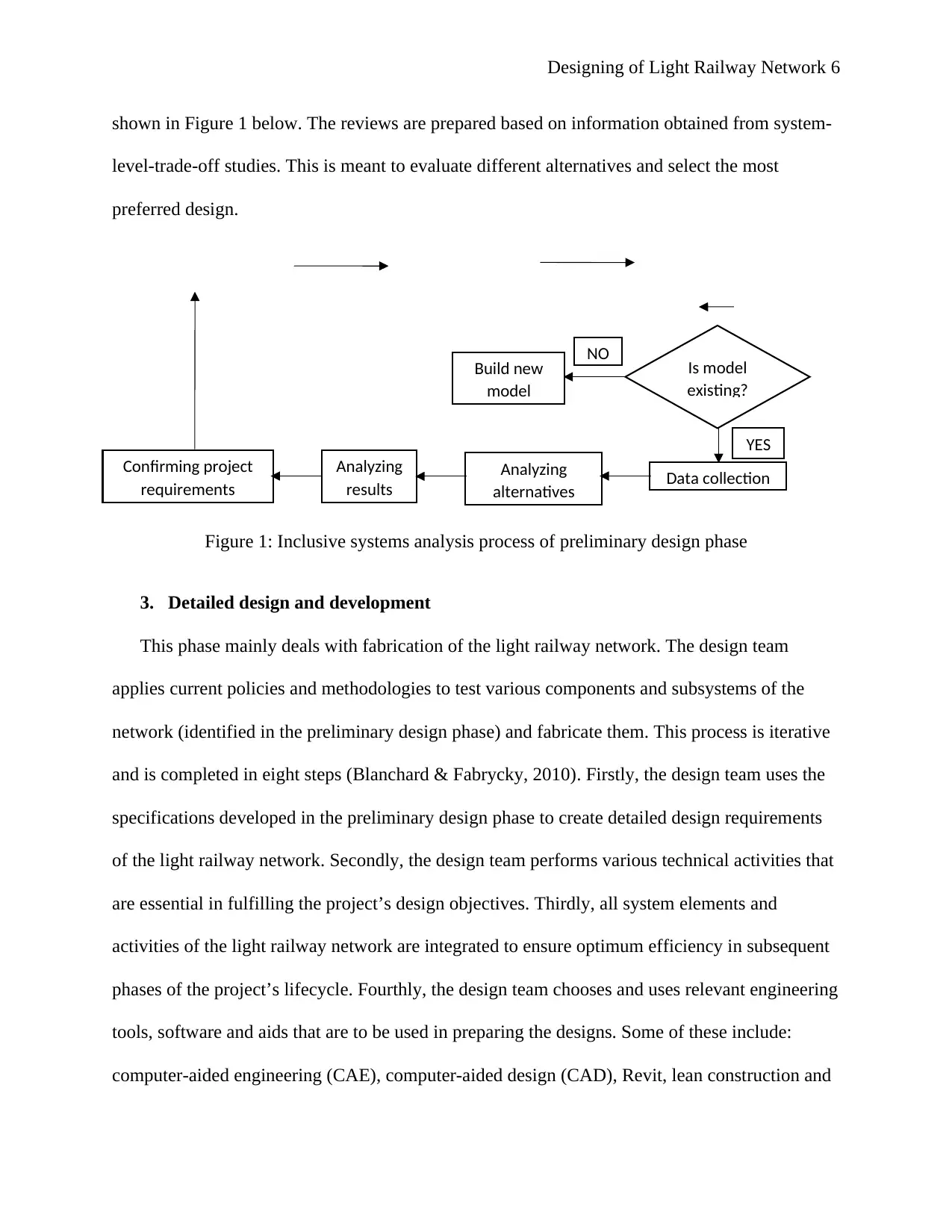
Designing of Light Railway Network 6
shown in Figure 1 below. The reviews are prepared based on information obtained from system-
level-trade-off studies. This is meant to evaluate different alternatives and select the most
preferred design.
Figure 1: Inclusive systems analysis process of preliminary design phase
3. Detailed design and development
This phase mainly deals with fabrication of the light railway network. The design team
applies current policies and methodologies to test various components and subsystems of the
network (identified in the preliminary design phase) and fabricate them. This process is iterative
and is completed in eight steps (Blanchard & Fabrycky, 2010). Firstly, the design team uses the
specifications developed in the preliminary design phase to create detailed design requirements
of the light railway network. Secondly, the design team performs various technical activities that
are essential in fulfilling the project’s design objectives. Thirdly, all system elements and
activities of the light railway network are integrated to ensure optimum efficiency in subsequent
phases of the project’s lifecycle. Fourthly, the design team chooses and uses relevant engineering
tools, software and aids that are to be used in preparing the designs. Some of these include:
computer-aided engineering (CAE), computer-aided design (CAD), Revit, lean construction and
Is model
existing?
NO
YES
Build new
model
Data collection
Analyzing
alternatives
Analyzing
results
Confirming project
requirements
shown in Figure 1 below. The reviews are prepared based on information obtained from system-
level-trade-off studies. This is meant to evaluate different alternatives and select the most
preferred design.
Figure 1: Inclusive systems analysis process of preliminary design phase
3. Detailed design and development
This phase mainly deals with fabrication of the light railway network. The design team
applies current policies and methodologies to test various components and subsystems of the
network (identified in the preliminary design phase) and fabricate them. This process is iterative
and is completed in eight steps (Blanchard & Fabrycky, 2010). Firstly, the design team uses the
specifications developed in the preliminary design phase to create detailed design requirements
of the light railway network. Secondly, the design team performs various technical activities that
are essential in fulfilling the project’s design objectives. Thirdly, all system elements and
activities of the light railway network are integrated to ensure optimum efficiency in subsequent
phases of the project’s lifecycle. Fourthly, the design team chooses and uses relevant engineering
tools, software and aids that are to be used in preparing the designs. Some of these include:
computer-aided engineering (CAE), computer-aided design (CAD), Revit, lean construction and
Is model
existing?
NO
YES
Build new
model
Data collection
Analyzing
alternatives
Analyzing
results
Confirming project
requirements
⊘ This is a preview!⊘
Do you want full access?
Subscribe today to unlock all pages.

Trusted by 1+ million students worldwide
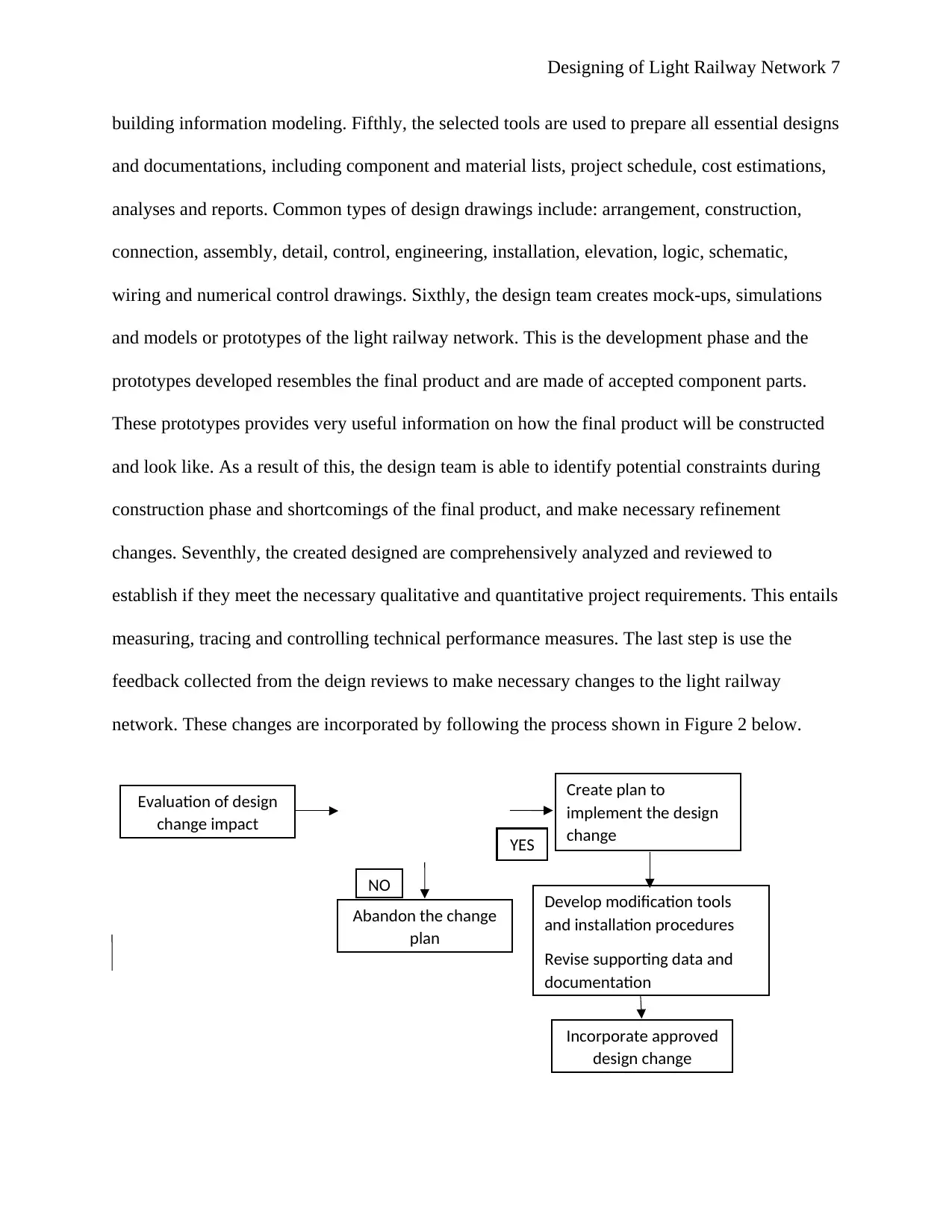
Designing of Light Railway Network 7
building information modeling. Fifthly, the selected tools are used to prepare all essential designs
and documentations, including component and material lists, project schedule, cost estimations,
analyses and reports. Common types of design drawings include: arrangement, construction,
connection, assembly, detail, control, engineering, installation, elevation, logic, schematic,
wiring and numerical control drawings. Sixthly, the design team creates mock-ups, simulations
and models or prototypes of the light railway network. This is the development phase and the
prototypes developed resembles the final product and are made of accepted component parts.
These prototypes provides very useful information on how the final product will be constructed
and look like. As a result of this, the design team is able to identify potential constraints during
construction phase and shortcomings of the final product, and make necessary refinement
changes. Seventhly, the created designed are comprehensively analyzed and reviewed to
establish if they meet the necessary qualitative and quantitative project requirements. This entails
measuring, tracing and controlling technical performance measures. The last step is use the
feedback collected from the deign reviews to make necessary changes to the light railway
network. These changes are incorporated by following the process shown in Figure 2 below.
Evaluation of design
change impact
NO
YES
Create plan to
implement the design
change
Abandon the change
plan
Develop modification tools
and installation procedures
Revise supporting data and
documentation
Incorporate approved
design change
building information modeling. Fifthly, the selected tools are used to prepare all essential designs
and documentations, including component and material lists, project schedule, cost estimations,
analyses and reports. Common types of design drawings include: arrangement, construction,
connection, assembly, detail, control, engineering, installation, elevation, logic, schematic,
wiring and numerical control drawings. Sixthly, the design team creates mock-ups, simulations
and models or prototypes of the light railway network. This is the development phase and the
prototypes developed resembles the final product and are made of accepted component parts.
These prototypes provides very useful information on how the final product will be constructed
and look like. As a result of this, the design team is able to identify potential constraints during
construction phase and shortcomings of the final product, and make necessary refinement
changes. Seventhly, the created designed are comprehensively analyzed and reviewed to
establish if they meet the necessary qualitative and quantitative project requirements. This entails
measuring, tracing and controlling technical performance measures. The last step is use the
feedback collected from the deign reviews to make necessary changes to the light railway
network. These changes are incorporated by following the process shown in Figure 2 below.
Evaluation of design
change impact
NO
YES
Create plan to
implement the design
change
Abandon the change
plan
Develop modification tools
and installation procedures
Revise supporting data and
documentation
Incorporate approved
design change
Paraphrase This Document
Need a fresh take? Get an instant paraphrase of this document with our AI Paraphraser
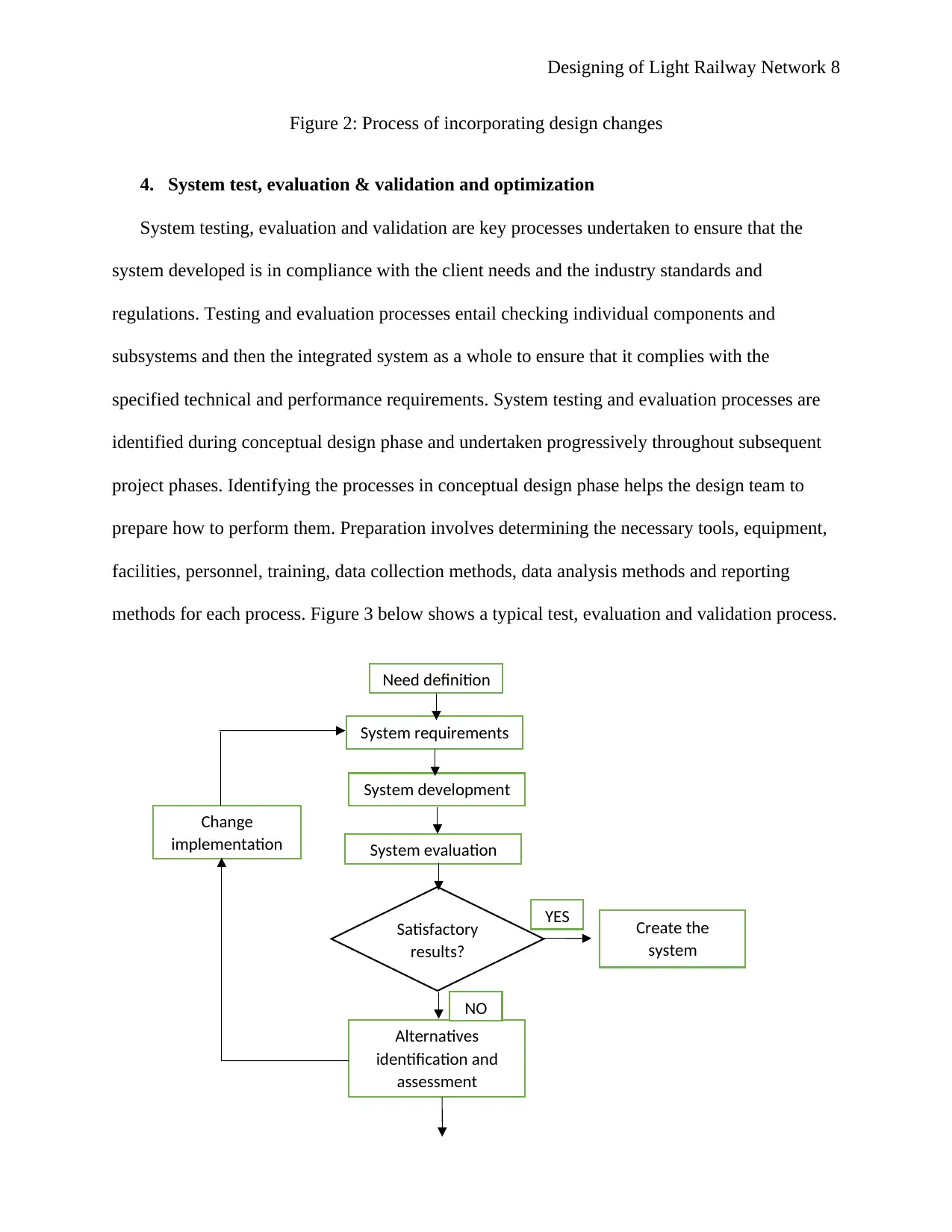
Designing of Light Railway Network 8
Figure 2: Process of incorporating design changes
4. System test, evaluation & validation and optimization
System testing, evaluation and validation are key processes undertaken to ensure that the
system developed is in compliance with the client needs and the industry standards and
regulations. Testing and evaluation processes entail checking individual components and
subsystems and then the integrated system as a whole to ensure that it complies with the
specified technical and performance requirements. System testing and evaluation processes are
identified during conceptual design phase and undertaken progressively throughout subsequent
project phases. Identifying the processes in conceptual design phase helps the design team to
prepare how to perform them. Preparation involves determining the necessary tools, equipment,
facilities, personnel, training, data collection methods, data analysis methods and reporting
methods for each process. Figure 3 below shows a typical test, evaluation and validation process.
Need definition
Change
implementation
System requirements
System development
System evaluation
Satisfactory
results?
Alternatives
identification and
assessment
NO
YES Create the
system
Figure 2: Process of incorporating design changes
4. System test, evaluation & validation and optimization
System testing, evaluation and validation are key processes undertaken to ensure that the
system developed is in compliance with the client needs and the industry standards and
regulations. Testing and evaluation processes entail checking individual components and
subsystems and then the integrated system as a whole to ensure that it complies with the
specified technical and performance requirements. System testing and evaluation processes are
identified during conceptual design phase and undertaken progressively throughout subsequent
project phases. Identifying the processes in conceptual design phase helps the design team to
prepare how to perform them. Preparation involves determining the necessary tools, equipment,
facilities, personnel, training, data collection methods, data analysis methods and reporting
methods for each process. Figure 3 below shows a typical test, evaluation and validation process.
Need definition
Change
implementation
System requirements
System development
System evaluation
Satisfactory
results?
Alternatives
identification and
assessment
NO
YES Create the
system
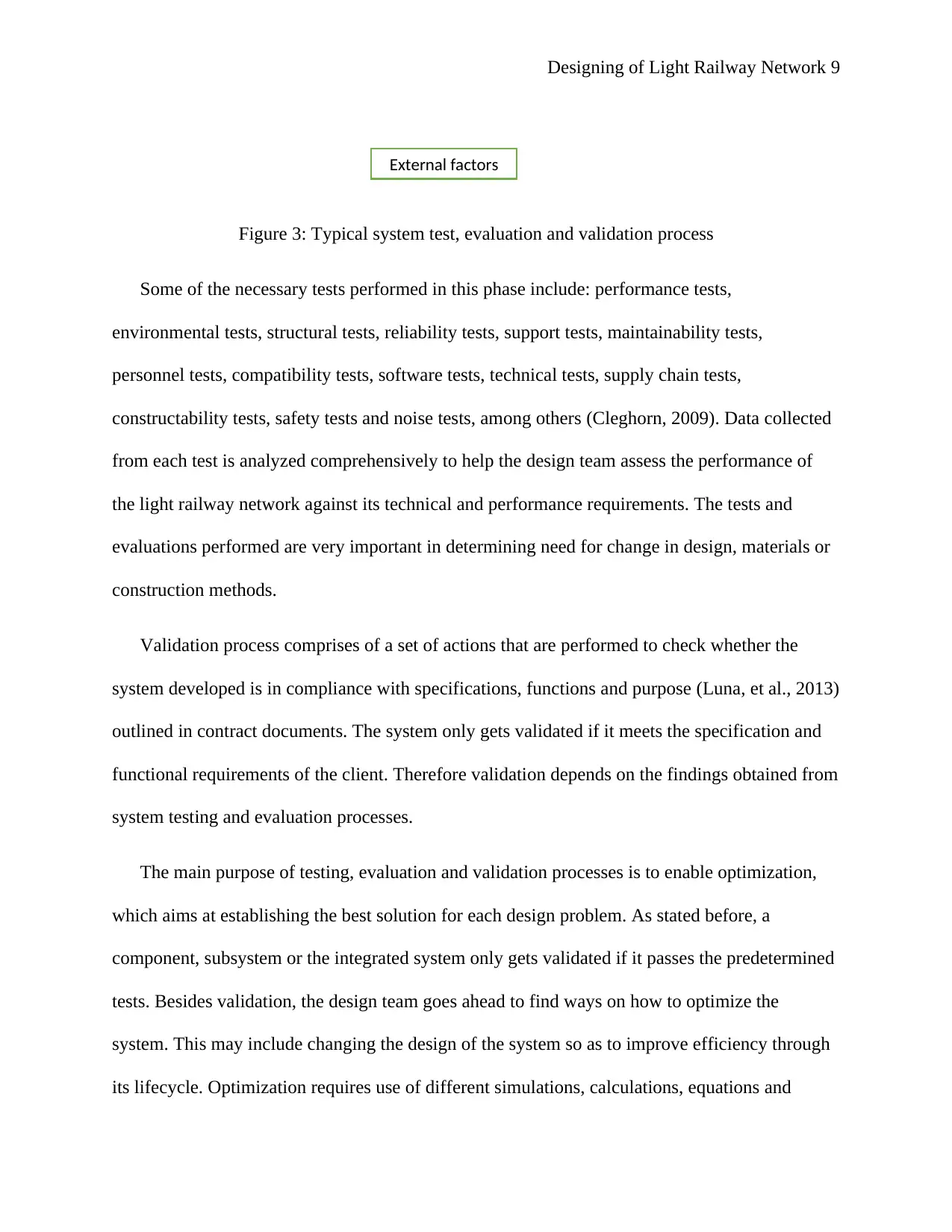
Designing of Light Railway Network 9
Figure 3: Typical system test, evaluation and validation process
Some of the necessary tests performed in this phase include: performance tests,
environmental tests, structural tests, reliability tests, support tests, maintainability tests,
personnel tests, compatibility tests, software tests, technical tests, supply chain tests,
constructability tests, safety tests and noise tests, among others (Cleghorn, 2009). Data collected
from each test is analyzed comprehensively to help the design team assess the performance of
the light railway network against its technical and performance requirements. The tests and
evaluations performed are very important in determining need for change in design, materials or
construction methods.
Validation process comprises of a set of actions that are performed to check whether the
system developed is in compliance with specifications, functions and purpose (Luna, et al., 2013)
outlined in contract documents. The system only gets validated if it meets the specification and
functional requirements of the client. Therefore validation depends on the findings obtained from
system testing and evaluation processes.
The main purpose of testing, evaluation and validation processes is to enable optimization,
which aims at establishing the best solution for each design problem. As stated before, a
component, subsystem or the integrated system only gets validated if it passes the predetermined
tests. Besides validation, the design team goes ahead to find ways on how to optimize the
system. This may include changing the design of the system so as to improve efficiency through
its lifecycle. Optimization requires use of different simulations, calculations, equations and
External factors
Figure 3: Typical system test, evaluation and validation process
Some of the necessary tests performed in this phase include: performance tests,
environmental tests, structural tests, reliability tests, support tests, maintainability tests,
personnel tests, compatibility tests, software tests, technical tests, supply chain tests,
constructability tests, safety tests and noise tests, among others (Cleghorn, 2009). Data collected
from each test is analyzed comprehensively to help the design team assess the performance of
the light railway network against its technical and performance requirements. The tests and
evaluations performed are very important in determining need for change in design, materials or
construction methods.
Validation process comprises of a set of actions that are performed to check whether the
system developed is in compliance with specifications, functions and purpose (Luna, et al., 2013)
outlined in contract documents. The system only gets validated if it meets the specification and
functional requirements of the client. Therefore validation depends on the findings obtained from
system testing and evaluation processes.
The main purpose of testing, evaluation and validation processes is to enable optimization,
which aims at establishing the best solution for each design problem. As stated before, a
component, subsystem or the integrated system only gets validated if it passes the predetermined
tests. Besides validation, the design team goes ahead to find ways on how to optimize the
system. This may include changing the design of the system so as to improve efficiency through
its lifecycle. Optimization requires use of different simulations, calculations, equations and
External factors
⊘ This is a preview!⊘
Do you want full access?
Subscribe today to unlock all pages.

Trusted by 1+ million students worldwide

Designing of Light Railway Network 10
mathematical formulae to understand the implications of different parameters of the light railway
network. Examples of optimizations include: use of renewable energy, use of lean construction
techniques, use of locally available materials, etc. The general objective of optimization is to
improve the technical and performance capability of the system at the least cost.
5. Human factors
There are several human factors that must be taken into account when developing a light
railway network. The fundamental goal of these factors is to ensure that the light railway
network is designed and constructed by considering its interaction with users. One of the key
human factors in this project is safety. The light railway system should be designed and
constructed to ensure total safety of drivers, crew and passengers. This can be achieved through
proper designs, appropriate selection of materials, use of suitable construction methods and
comprehensive testing and evaluation of the system. During operation phase, safety of
passengers can also be attained by ensuring that the light railway vehicles are driven by qualified
personnel provided with all the necessary resources and space to perform their roles (Naweed &
Moody, 2015) to avoid trauma (Mitra, et al., 2010), maintained properly, driven at recommended
speed and not overloaded. The light railway network should also have reliable and properly
maintained traffic signals (Dobson, 2015) and other railway furniture that improve safety of
passengers at boarding stations and stops.
Comfort is another human factor. The light railway network should be developed with the
drivers, crew and passengers in mind from the very early stage. This is achieved by ensuring that
light railway vehicles have suitable types and sizes of seats, adequate leg spaces, proper
ventilation and air conditioning systems, appropriate sound and vibration insulation, etc. The
design team must consider several anthropometric factors such as body dimensions, sitting and
mathematical formulae to understand the implications of different parameters of the light railway
network. Examples of optimizations include: use of renewable energy, use of lean construction
techniques, use of locally available materials, etc. The general objective of optimization is to
improve the technical and performance capability of the system at the least cost.
5. Human factors
There are several human factors that must be taken into account when developing a light
railway network. The fundamental goal of these factors is to ensure that the light railway
network is designed and constructed by considering its interaction with users. One of the key
human factors in this project is safety. The light railway system should be designed and
constructed to ensure total safety of drivers, crew and passengers. This can be achieved through
proper designs, appropriate selection of materials, use of suitable construction methods and
comprehensive testing and evaluation of the system. During operation phase, safety of
passengers can also be attained by ensuring that the light railway vehicles are driven by qualified
personnel provided with all the necessary resources and space to perform their roles (Naweed &
Moody, 2015) to avoid trauma (Mitra, et al., 2010), maintained properly, driven at recommended
speed and not overloaded. The light railway network should also have reliable and properly
maintained traffic signals (Dobson, 2015) and other railway furniture that improve safety of
passengers at boarding stations and stops.
Comfort is another human factor. The light railway network should be developed with the
drivers, crew and passengers in mind from the very early stage. This is achieved by ensuring that
light railway vehicles have suitable types and sizes of seats, adequate leg spaces, proper
ventilation and air conditioning systems, appropriate sound and vibration insulation, etc. The
design team must consider several anthropometric factors such as body dimensions, sitting and
Paraphrase This Document
Need a fresh take? Get an instant paraphrase of this document with our AI Paraphraser
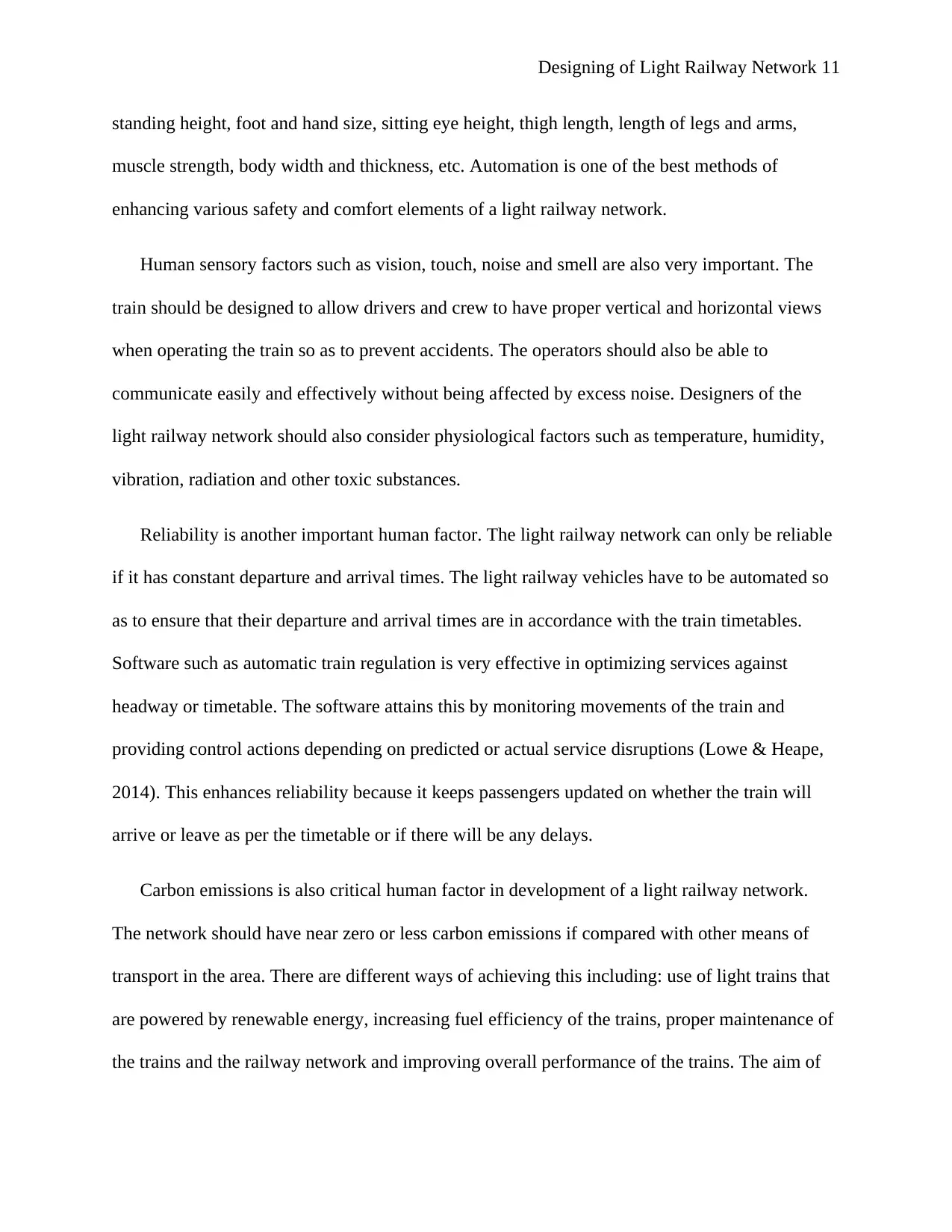
Designing of Light Railway Network 11
standing height, foot and hand size, sitting eye height, thigh length, length of legs and arms,
muscle strength, body width and thickness, etc. Automation is one of the best methods of
enhancing various safety and comfort elements of a light railway network.
Human sensory factors such as vision, touch, noise and smell are also very important. The
train should be designed to allow drivers and crew to have proper vertical and horizontal views
when operating the train so as to prevent accidents. The operators should also be able to
communicate easily and effectively without being affected by excess noise. Designers of the
light railway network should also consider physiological factors such as temperature, humidity,
vibration, radiation and other toxic substances.
Reliability is another important human factor. The light railway network can only be reliable
if it has constant departure and arrival times. The light railway vehicles have to be automated so
as to ensure that their departure and arrival times are in accordance with the train timetables.
Software such as automatic train regulation is very effective in optimizing services against
headway or timetable. The software attains this by monitoring movements of the train and
providing control actions depending on predicted or actual service disruptions (Lowe & Heape,
2014). This enhances reliability because it keeps passengers updated on whether the train will
arrive or leave as per the timetable or if there will be any delays.
Carbon emissions is also critical human factor in development of a light railway network.
The network should have near zero or less carbon emissions if compared with other means of
transport in the area. There are different ways of achieving this including: use of light trains that
are powered by renewable energy, increasing fuel efficiency of the trains, proper maintenance of
the trains and the railway network and improving overall performance of the trains. The aim of
standing height, foot and hand size, sitting eye height, thigh length, length of legs and arms,
muscle strength, body width and thickness, etc. Automation is one of the best methods of
enhancing various safety and comfort elements of a light railway network.
Human sensory factors such as vision, touch, noise and smell are also very important. The
train should be designed to allow drivers and crew to have proper vertical and horizontal views
when operating the train so as to prevent accidents. The operators should also be able to
communicate easily and effectively without being affected by excess noise. Designers of the
light railway network should also consider physiological factors such as temperature, humidity,
vibration, radiation and other toxic substances.
Reliability is another important human factor. The light railway network can only be reliable
if it has constant departure and arrival times. The light railway vehicles have to be automated so
as to ensure that their departure and arrival times are in accordance with the train timetables.
Software such as automatic train regulation is very effective in optimizing services against
headway or timetable. The software attains this by monitoring movements of the train and
providing control actions depending on predicted or actual service disruptions (Lowe & Heape,
2014). This enhances reliability because it keeps passengers updated on whether the train will
arrive or leave as per the timetable or if there will be any delays.
Carbon emissions is also critical human factor in development of a light railway network.
The network should have near zero or less carbon emissions if compared with other means of
transport in the area. There are different ways of achieving this including: use of light trains that
are powered by renewable energy, increasing fuel efficiency of the trains, proper maintenance of
the trains and the railway network and improving overall performance of the trains. The aim of
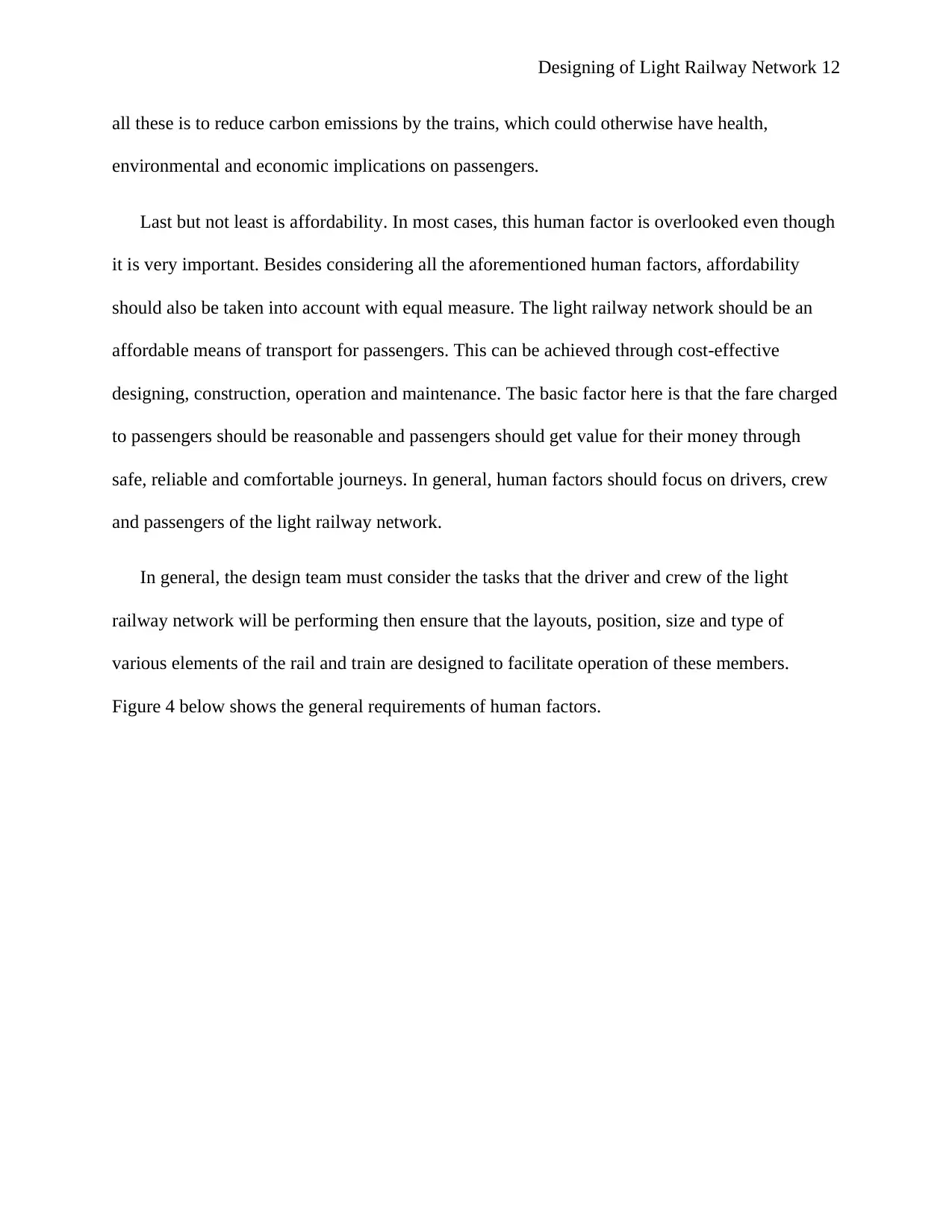
Designing of Light Railway Network 12
all these is to reduce carbon emissions by the trains, which could otherwise have health,
environmental and economic implications on passengers.
Last but not least is affordability. In most cases, this human factor is overlooked even though
it is very important. Besides considering all the aforementioned human factors, affordability
should also be taken into account with equal measure. The light railway network should be an
affordable means of transport for passengers. This can be achieved through cost-effective
designing, construction, operation and maintenance. The basic factor here is that the fare charged
to passengers should be reasonable and passengers should get value for their money through
safe, reliable and comfortable journeys. In general, human factors should focus on drivers, crew
and passengers of the light railway network.
In general, the design team must consider the tasks that the driver and crew of the light
railway network will be performing then ensure that the layouts, position, size and type of
various elements of the rail and train are designed to facilitate operation of these members.
Figure 4 below shows the general requirements of human factors.
all these is to reduce carbon emissions by the trains, which could otherwise have health,
environmental and economic implications on passengers.
Last but not least is affordability. In most cases, this human factor is overlooked even though
it is very important. Besides considering all the aforementioned human factors, affordability
should also be taken into account with equal measure. The light railway network should be an
affordable means of transport for passengers. This can be achieved through cost-effective
designing, construction, operation and maintenance. The basic factor here is that the fare charged
to passengers should be reasonable and passengers should get value for their money through
safe, reliable and comfortable journeys. In general, human factors should focus on drivers, crew
and passengers of the light railway network.
In general, the design team must consider the tasks that the driver and crew of the light
railway network will be performing then ensure that the layouts, position, size and type of
various elements of the rail and train are designed to facilitate operation of these members.
Figure 4 below shows the general requirements of human factors.
⊘ This is a preview!⊘
Do you want full access?
Subscribe today to unlock all pages.

Trusted by 1+ million students worldwide
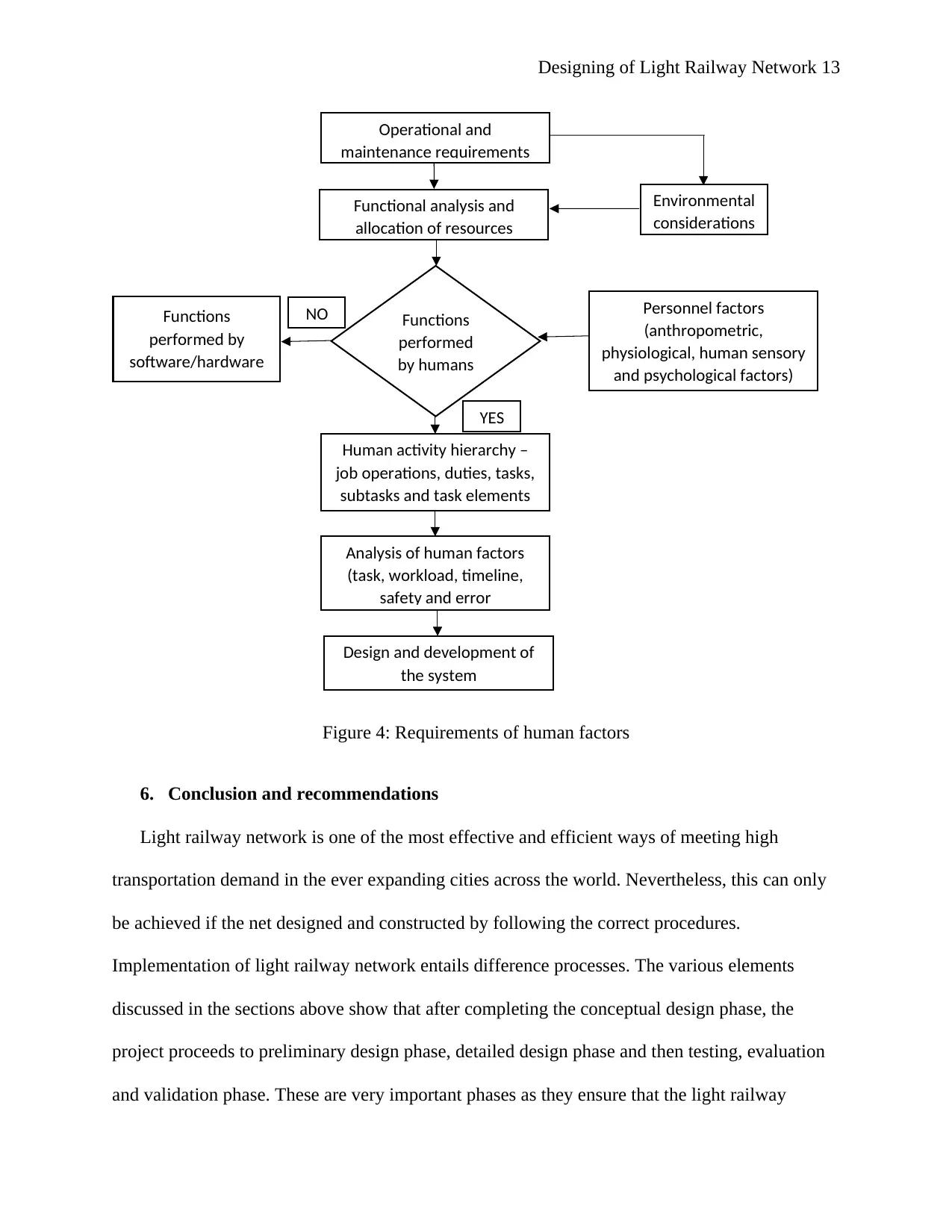
Designing of Light Railway Network 13
Figure 4: Requirements of human factors
6. Conclusion and recommendations
Light railway network is one of the most effective and efficient ways of meeting high
transportation demand in the ever expanding cities across the world. Nevertheless, this can only
be achieved if the net designed and constructed by following the correct procedures.
Implementation of light railway network entails difference processes. The various elements
discussed in the sections above show that after completing the conceptual design phase, the
project proceeds to preliminary design phase, detailed design phase and then testing, evaluation
and validation phase. These are very important phases as they ensure that the light railway
Operational and
maintenance requirements
Functional analysis and
allocation of resources
Human activity hierarchy –
job operations, duties, tasks,
subtasks and task elements
Analysis of human factors
(task, workload, timeline,
safety and error
Design and development of
the system
Environmental
considerations
Personnel factors
(anthropometric,
physiological, human sensory
and psychological factors)
Functions
performed
by humans
Functions
performed by
software/hardware
NO
YES
Figure 4: Requirements of human factors
6. Conclusion and recommendations
Light railway network is one of the most effective and efficient ways of meeting high
transportation demand in the ever expanding cities across the world. Nevertheless, this can only
be achieved if the net designed and constructed by following the correct procedures.
Implementation of light railway network entails difference processes. The various elements
discussed in the sections above show that after completing the conceptual design phase, the
project proceeds to preliminary design phase, detailed design phase and then testing, evaluation
and validation phase. These are very important phases as they ensure that the light railway
Operational and
maintenance requirements
Functional analysis and
allocation of resources
Human activity hierarchy –
job operations, duties, tasks,
subtasks and task elements
Analysis of human factors
(task, workload, timeline,
safety and error
Design and development of
the system
Environmental
considerations
Personnel factors
(anthropometric,
physiological, human sensory
and psychological factors)
Functions
performed
by humans
Functions
performed by
software/hardware
NO
YES
Paraphrase This Document
Need a fresh take? Get an instant paraphrase of this document with our AI Paraphraser
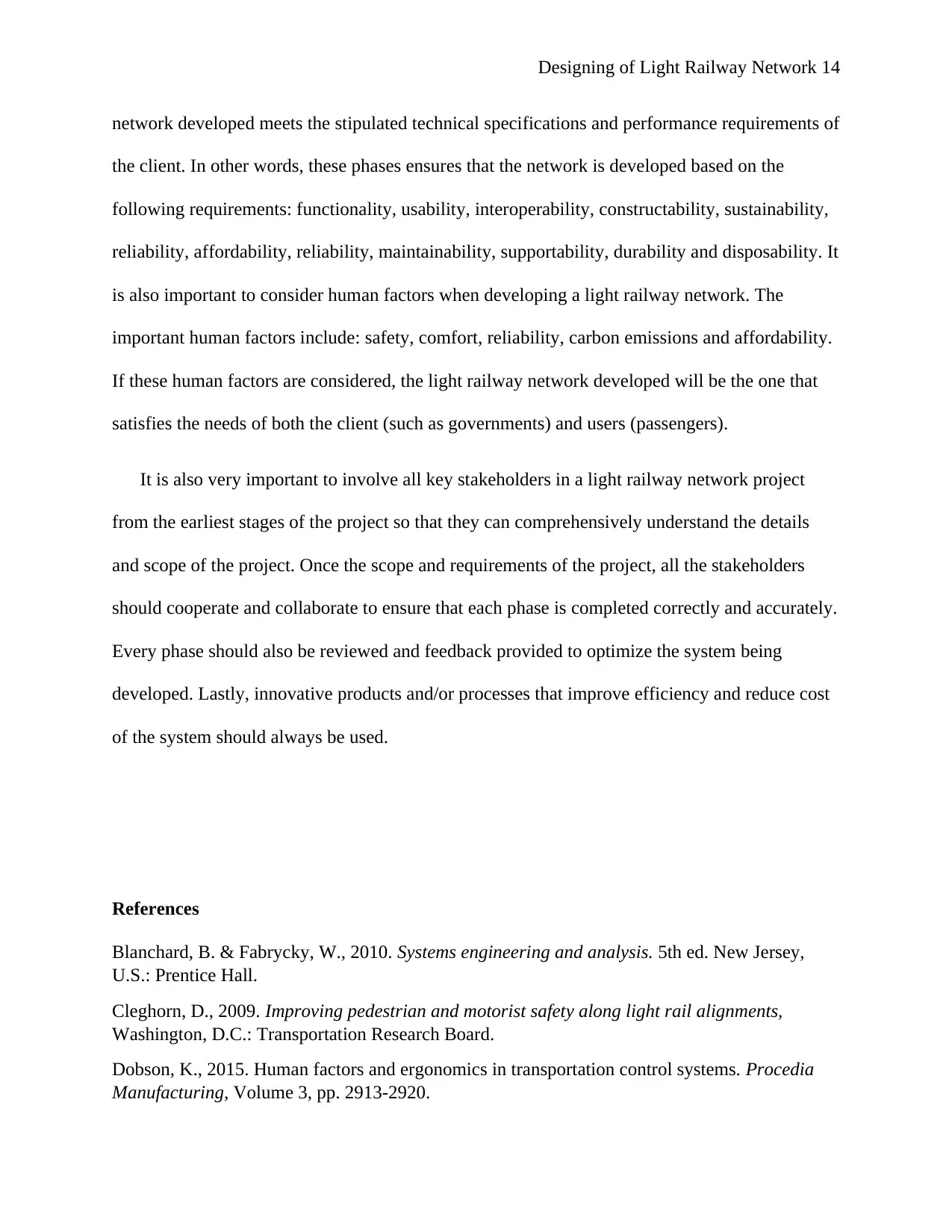
Designing of Light Railway Network 14
network developed meets the stipulated technical specifications and performance requirements of
the client. In other words, these phases ensures that the network is developed based on the
following requirements: functionality, usability, interoperability, constructability, sustainability,
reliability, affordability, reliability, maintainability, supportability, durability and disposability. It
is also important to consider human factors when developing a light railway network. The
important human factors include: safety, comfort, reliability, carbon emissions and affordability.
If these human factors are considered, the light railway network developed will be the one that
satisfies the needs of both the client (such as governments) and users (passengers).
It is also very important to involve all key stakeholders in a light railway network project
from the earliest stages of the project so that they can comprehensively understand the details
and scope of the project. Once the scope and requirements of the project, all the stakeholders
should cooperate and collaborate to ensure that each phase is completed correctly and accurately.
Every phase should also be reviewed and feedback provided to optimize the system being
developed. Lastly, innovative products and/or processes that improve efficiency and reduce cost
of the system should always be used.
References
Blanchard, B. & Fabrycky, W., 2010. Systems engineering and analysis. 5th ed. New Jersey,
U.S.: Prentice Hall.
Cleghorn, D., 2009. Improving pedestrian and motorist safety along light rail alignments,
Washington, D.C.: Transportation Research Board.
Dobson, K., 2015. Human factors and ergonomics in transportation control systems. Procedia
Manufacturing, Volume 3, pp. 2913-2920.
network developed meets the stipulated technical specifications and performance requirements of
the client. In other words, these phases ensures that the network is developed based on the
following requirements: functionality, usability, interoperability, constructability, sustainability,
reliability, affordability, reliability, maintainability, supportability, durability and disposability. It
is also important to consider human factors when developing a light railway network. The
important human factors include: safety, comfort, reliability, carbon emissions and affordability.
If these human factors are considered, the light railway network developed will be the one that
satisfies the needs of both the client (such as governments) and users (passengers).
It is also very important to involve all key stakeholders in a light railway network project
from the earliest stages of the project so that they can comprehensively understand the details
and scope of the project. Once the scope and requirements of the project, all the stakeholders
should cooperate and collaborate to ensure that each phase is completed correctly and accurately.
Every phase should also be reviewed and feedback provided to optimize the system being
developed. Lastly, innovative products and/or processes that improve efficiency and reduce cost
of the system should always be used.
References
Blanchard, B. & Fabrycky, W., 2010. Systems engineering and analysis. 5th ed. New Jersey,
U.S.: Prentice Hall.
Cleghorn, D., 2009. Improving pedestrian and motorist safety along light rail alignments,
Washington, D.C.: Transportation Research Board.
Dobson, K., 2015. Human factors and ergonomics in transportation control systems. Procedia
Manufacturing, Volume 3, pp. 2913-2920.
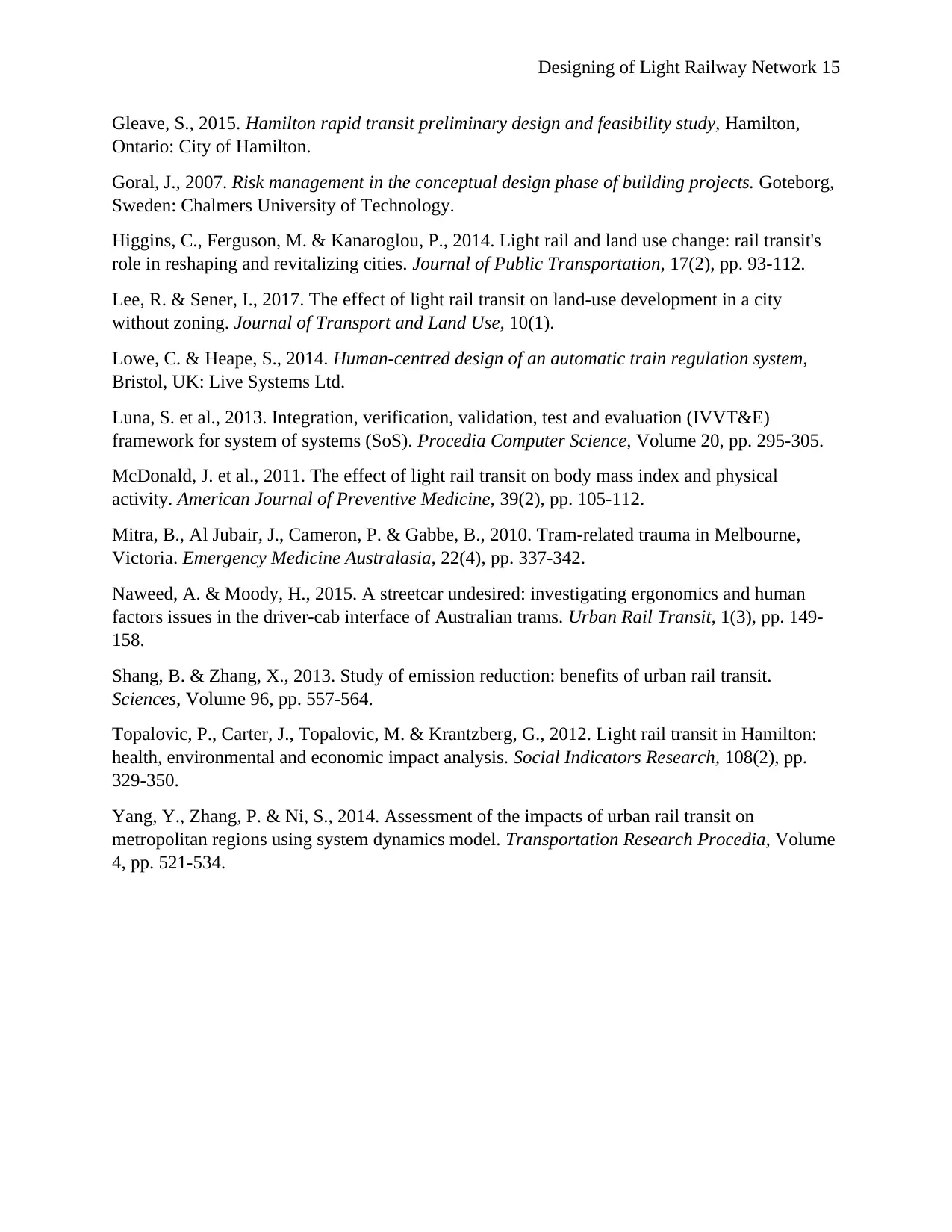
Designing of Light Railway Network 15
Gleave, S., 2015. Hamilton rapid transit preliminary design and feasibility study, Hamilton,
Ontario: City of Hamilton.
Goral, J., 2007. Risk management in the conceptual design phase of building projects. Goteborg,
Sweden: Chalmers University of Technology.
Higgins, C., Ferguson, M. & Kanaroglou, P., 2014. Light rail and land use change: rail transit's
role in reshaping and revitalizing cities. Journal of Public Transportation, 17(2), pp. 93-112.
Lee, R. & Sener, I., 2017. The effect of light rail transit on land-use development in a city
without zoning. Journal of Transport and Land Use, 10(1).
Lowe, C. & Heape, S., 2014. Human-centred design of an automatic train regulation system,
Bristol, UK: Live Systems Ltd.
Luna, S. et al., 2013. Integration, verification, validation, test and evaluation (IVVT&E)
framework for system of systems (SoS). Procedia Computer Science, Volume 20, pp. 295-305.
McDonald, J. et al., 2011. The effect of light rail transit on body mass index and physical
activity. American Journal of Preventive Medicine, 39(2), pp. 105-112.
Mitra, B., Al Jubair, J., Cameron, P. & Gabbe, B., 2010. Tram-related trauma in Melbourne,
Victoria. Emergency Medicine Australasia, 22(4), pp. 337-342.
Naweed, A. & Moody, H., 2015. A streetcar undesired: investigating ergonomics and human
factors issues in the driver-cab interface of Australian trams. Urban Rail Transit, 1(3), pp. 149-
158.
Shang, B. & Zhang, X., 2013. Study of emission reduction: benefits of urban rail transit.
Sciences, Volume 96, pp. 557-564.
Topalovic, P., Carter, J., Topalovic, M. & Krantzberg, G., 2012. Light rail transit in Hamilton:
health, environmental and economic impact analysis. Social Indicators Research, 108(2), pp.
329-350.
Yang, Y., Zhang, P. & Ni, S., 2014. Assessment of the impacts of urban rail transit on
metropolitan regions using system dynamics model. Transportation Research Procedia, Volume
4, pp. 521-534.
Gleave, S., 2015. Hamilton rapid transit preliminary design and feasibility study, Hamilton,
Ontario: City of Hamilton.
Goral, J., 2007. Risk management in the conceptual design phase of building projects. Goteborg,
Sweden: Chalmers University of Technology.
Higgins, C., Ferguson, M. & Kanaroglou, P., 2014. Light rail and land use change: rail transit's
role in reshaping and revitalizing cities. Journal of Public Transportation, 17(2), pp. 93-112.
Lee, R. & Sener, I., 2017. The effect of light rail transit on land-use development in a city
without zoning. Journal of Transport and Land Use, 10(1).
Lowe, C. & Heape, S., 2014. Human-centred design of an automatic train regulation system,
Bristol, UK: Live Systems Ltd.
Luna, S. et al., 2013. Integration, verification, validation, test and evaluation (IVVT&E)
framework for system of systems (SoS). Procedia Computer Science, Volume 20, pp. 295-305.
McDonald, J. et al., 2011. The effect of light rail transit on body mass index and physical
activity. American Journal of Preventive Medicine, 39(2), pp. 105-112.
Mitra, B., Al Jubair, J., Cameron, P. & Gabbe, B., 2010. Tram-related trauma in Melbourne,
Victoria. Emergency Medicine Australasia, 22(4), pp. 337-342.
Naweed, A. & Moody, H., 2015. A streetcar undesired: investigating ergonomics and human
factors issues in the driver-cab interface of Australian trams. Urban Rail Transit, 1(3), pp. 149-
158.
Shang, B. & Zhang, X., 2013. Study of emission reduction: benefits of urban rail transit.
Sciences, Volume 96, pp. 557-564.
Topalovic, P., Carter, J., Topalovic, M. & Krantzberg, G., 2012. Light rail transit in Hamilton:
health, environmental and economic impact analysis. Social Indicators Research, 108(2), pp.
329-350.
Yang, Y., Zhang, P. & Ni, S., 2014. Assessment of the impacts of urban rail transit on
metropolitan regions using system dynamics model. Transportation Research Procedia, Volume
4, pp. 521-534.
⊘ This is a preview!⊘
Do you want full access?
Subscribe today to unlock all pages.

Trusted by 1+ million students worldwide
1 out of 15
Related Documents
Your All-in-One AI-Powered Toolkit for Academic Success.
+13062052269
info@desklib.com
Available 24*7 on WhatsApp / Email
![[object Object]](/_next/static/media/star-bottom.7253800d.svg)
Unlock your academic potential
© 2024 | Zucol Services PVT LTD | All rights reserved.





